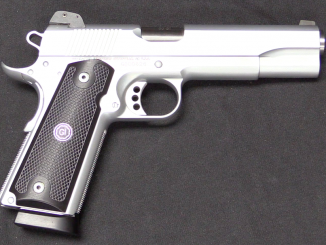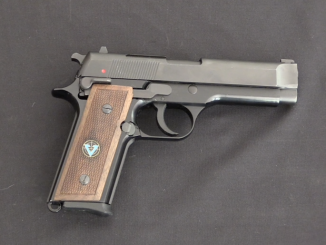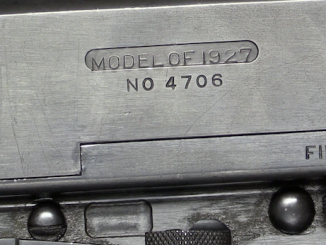A while back I put together a video on the development of the Colt/Browning 1911 pistol, and one of the missing links in that video was the Model 1909. Well, one of the 23 Model 1909 pistols is up for sale in this next Rock Island auction, so I took the opportunity to look at it more closely. The 1909 is the point where many of the distinctive elements of the 1911 first appear, including the grip safety, push-button magazine release, and the swinging link, tilting barrel operating mechanism. However, it still retains several of the elements of the early Colt/Browning pistols, like the nearly vertical grip and the lack of a thumb safety. Given that only 23 were made (and by the time the Army was actually testing them, Browning was already busy on the improved 1910 version), they are not the sort of gun you come across every day…
Related Articles

Semiauto pistol
A .50 Caliber 1911: Guncrafter Industries Model 1
This pistol sold for $2,300 at Rock Island on November 30, 2018. Guncrafter Industries is a custom handgun company formed by one Alex Zimmerman in 2002 after many years working for Wilson Combat. Among other […]

Prototype
Prototype Colt-Vektor: A 1911 on the Outside and a Beretta on the Inside
In the late 1990s Colt was looking for pistols it could license for sale in the United States, in the wake of the failures of both eh Double Eagle and All-American 2000. They approached CZ, […]

Semiauto pistol
Model 1927 Thompson Semi Automatic Carbine
One of the rarest versions of the Thompsons Submachine Gun is the Model of 1927 Thompson Semi Automatic Carbine. These were regular 1921 machine guns that had their fire control groups slightly modified to only […]

Thanks Ian and RIA. I had read about that model years ago but that was the first one I’d ever seen. I own a modern (1990’s) 1911A1 and your vidio was very instructive in it’s history.
Most distinctive feature of this model should be the difference in the way and construction of the take down process. Getting out the slide from the receiver from the front in a very similar way of FN 1903 uses, gets the pistol to a safe and dependable level from the dangerous application of old models which having a take down application with a backward slide dismounting.
The 1903’s disassembly procedure isn’t the same is it, you revolve the barrel. You mean, on that model the slide is removed from the front. Which presumably prevents it from, hitting you in the eye because it can’t come off that way.
Just you stated. Only a removable steel bar prevents slide fly out in Model 1903.
On modern pistols, that you remove the slide from the front… They can’t hit you in the eye, is that right? Because there’s something other than a removable steel bar stopping it, in certain circumstances. The design of the rear section of the frame for example, which necessities you removing the slide from the front while providing said protection.
D’oh the slide stop that sticky out thing offset on the rear of a 1911 I thought that was the ejector for some reason… So if the linkage broke, the side would hit the slide stop so preventing it from hitting you in the eye.
Actually is it also the ejector, trying to remember… The firing pin hole, and the extractor…
Thank you for excellent explanation of Browning pistol development. I was not aware of the fact that Browning designed and built pistols in .45cal prior to Mod.1911
Finish of guns (bluing?) is in remarkable good condition.
It’s interesting that the Colt 1905s had an external extractor, then in the 1911 they went to an internal extractor. Then when the Hi-power was designed initially they retained the internal extractor before later replacing it with an external one, I’d always been told, because of parts breakages.
did the 9MM Hi-power break it’s extractor more than the .45ACP 1911?
Internal extractor in Colt 1909/1911 was used simply for reducing the manufacturing costs and this was clearly stated in the patent texts by the inventor. GP35 internal extractor was used by the lack of enough room for external type by cause of the placement of the trigger force transmitter lever mounted inside the slide over a “U” shaped axis pin closing the possibility of cutting the recess for an external extractor. When roll pins were invented and became largely used, the form of extractor placement was changed and even in that form, the external extractor had to be mounted with a downward pitch for providing enough and secure room for the pass of trigger force transmitter lever axis roll pin. IMHO.
It occurs to me the whole extractor gymnastics on the BHP could be prevented by mounting the trigger transfer bar on the left side of the slide. It would necessitate routing around the ejector but I believe the Mk. III models proved that the transfer bar can be widened at the rear quite easily without undue concern.
I’m not sure how the internal extractor reduced costs. The external version of the BHP extractor looks like it is, or could be, stamped out of heavy gauge sheet steel. I’m not sure how 1911 extractors are made (some aftermarket ones are machined from bar stock) but it definitely isn’t stamped!
The old swinging design, provided a simple disassembly/reassembly method. Double linkages, more material on the frame with for one of them… Tilting version, single linkage less frame material but less simple in regards the above. I suppose you could put a raised portion like one of the barrel locking lugs on the upper rear chamber, which would protrude into the ejection port so catching the slide when fully open. The barrel would have to swing down more though, for disassembly/reassembly. You could have a knock out pin, through the frame which would sit behind the rear linkage propping it up in order it remains in the functioning position. Knock it out for disassembly/reassembly in order the barrel can swing lower and thus give the slide clearance of the new safety stop aforesaid. Depends if there’s any accuracy benefit in having it swing rather than tilt, given the material/simplicity differences between the two methods kind of balance each other out if the safety issuse of the slide being removed/attached from the rear is sorted out. Having the barrel tilt further for disassembly/reassembly as mentioned, would lead to some dimensional changes. But in theory the ejection port snagging on the chamber lug, should prevent the slide from hitting you if the main disassembly/reassembly pin broke. There’s room for a new pin through the frame under the slides lower edge somewhere around the front of trigger guard, might work.
Rear of the trigger guard, the rear linkage pin which is visible. So behind it, meaning if it wasn’t there. The linkage when in the lower position, would be lower yet. But when it was, the linkage in said position would rest on it.
Utilising a degree of hindsight, doing away with linkages in favour of shaped surfaces… To induce a back then drop motion could be be possibly be used, like on say a Glock. But front and back, then put the disassembly pin under the front one in a manner which enables it to engage with the slide as now. So, to disassemble/reassemble you would just knock one pin out allowing the barrel to lower further to give the “slide stopper” clearance. The front shaped surface on the barrel wouldn’t tip, because it would be engaging the corresponding ones in the frame- Which would allow it to drop and rise, simultaneously with the rear one while the barrel remains parallel perhaps.
Apart from it wouldn’t engage the recoil spring… Switch it round, it should work as above while engaging the spring.
Actually it needs two pins, otherwise it defies the point- If one fails, the other can’t allow the barrel to drop to the disassembly level otherwise the slide stopper wouldn’t engage the ejection port. Two captive pins, one in the current position. The other just through the frame acting as a stop for the barrels functioning lowest point.
When you look at the transition through these models, it seems the tilting barrel came around as a consequence of the disassembly/reassembly method changing i.e. instead of the slide moving from the rear it changed to the front. Because the swinging barrel, wasn’t feasible if you wished to move the slide from the front but a tilting bolt facilitated this. So the tilting barrel didn’t come around as of itself, it developed because of the change in were the slide is moved from and this came about because it was deemed safer if the slide couldn’t remove itself towards the firer in certain circumstances.
A walther type dismounting, taking the slide forward over the barrel after a slide guide restrictor taken out of path of the slide, can be used for an elevating type barrel lock. This would be safer and stroner than any other kind of take down and leave minimum of parts spreaded around after that process. Pitty, famous John Moses could not figured that.
Which model of Walther out of interest, is it similar to the ones used on say a p226. I was thinking given the long frame of the 1905, it’s shroud is it called these days on normal length ones “were the recoil spring is contained, on this” wouldn’t help disassembly from the front… But you can get full length shroud Cz75s target models, and they have a tilting barrel though with one rear linkage. If you had two linkages like these early models for a swinging barrel, would you need to remove the slide from the rear unless you come up with another way of doing it i.e. The Walther way for example would that only work with a tilting barrel as oppose swinging?
Sorry. I mean blowback models from 1 to 9 and double “P” series.
The trigger guards upper bit, would impact against the front of the slide thus preventing from hitting you in the eye?
Ah, get you, use that on a gun which doesn’t have a fixed barrel because the PP can’t hit you in the eye anyway. I did think of using the trigger guard in the manner you suggest somehow, prior to thinking about using a protrusion on chamber to engage the ejection port.
Maninlicher 1900 is the forerunner of this type of take down in fixed barrel models. For recoiling barrel models, it should be Steyr Model 1911. Though very similar in appearance, the take down of Steyr1911 needs slide taken over the “Remained on the frame” recoiling barrel. Slide fly out to rear to the face of shooter is not present on these pistols even if they use a similar steel bar to stop the slide rearward travel.
Thanks.
Most of these designs develop overtime really, sometimes the outcome depends on the start point so to speak. In relation to what you figure, eventually. I like the original method, looks simpler to manufacture might be alright in Polymer, cheaply.
Has anyone ever been hit in the eye by a 1905 slide? I realize the danger is there, but in practical terms I don’t think the steel bar is that likely to shear off unexpectedly. I have always heard this was a major weakness, but was it so major as to actually happen?
I thought that, but still. Better safe than sorry…